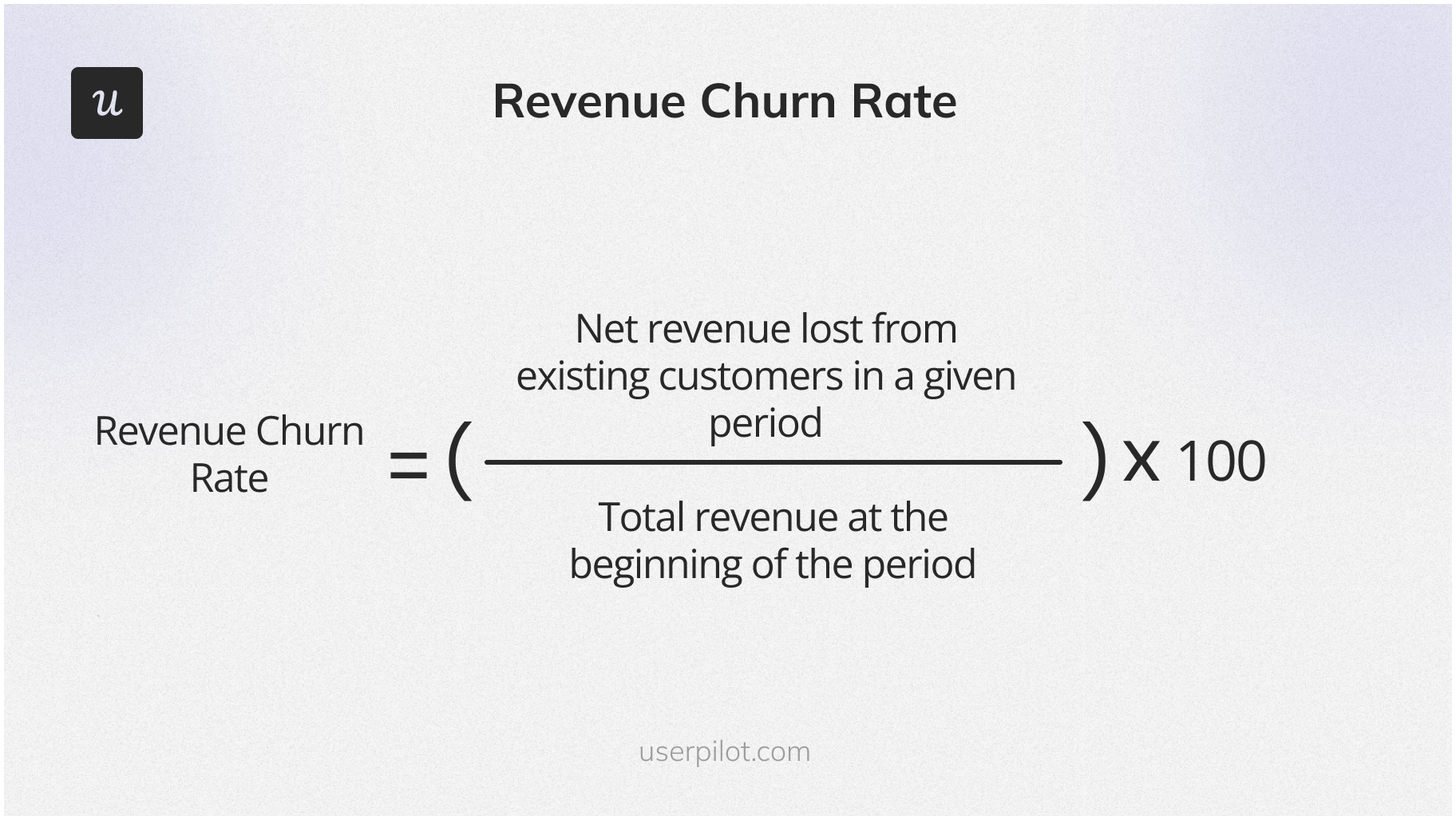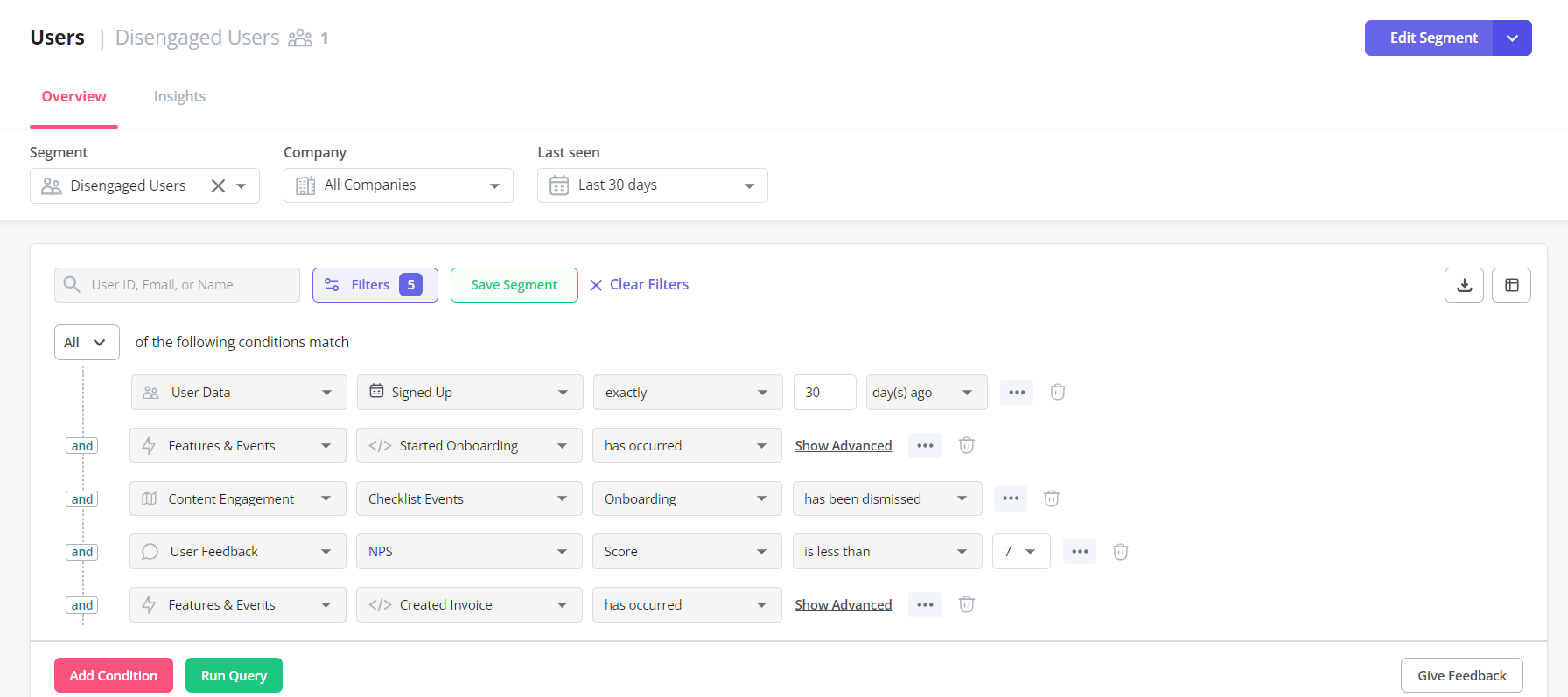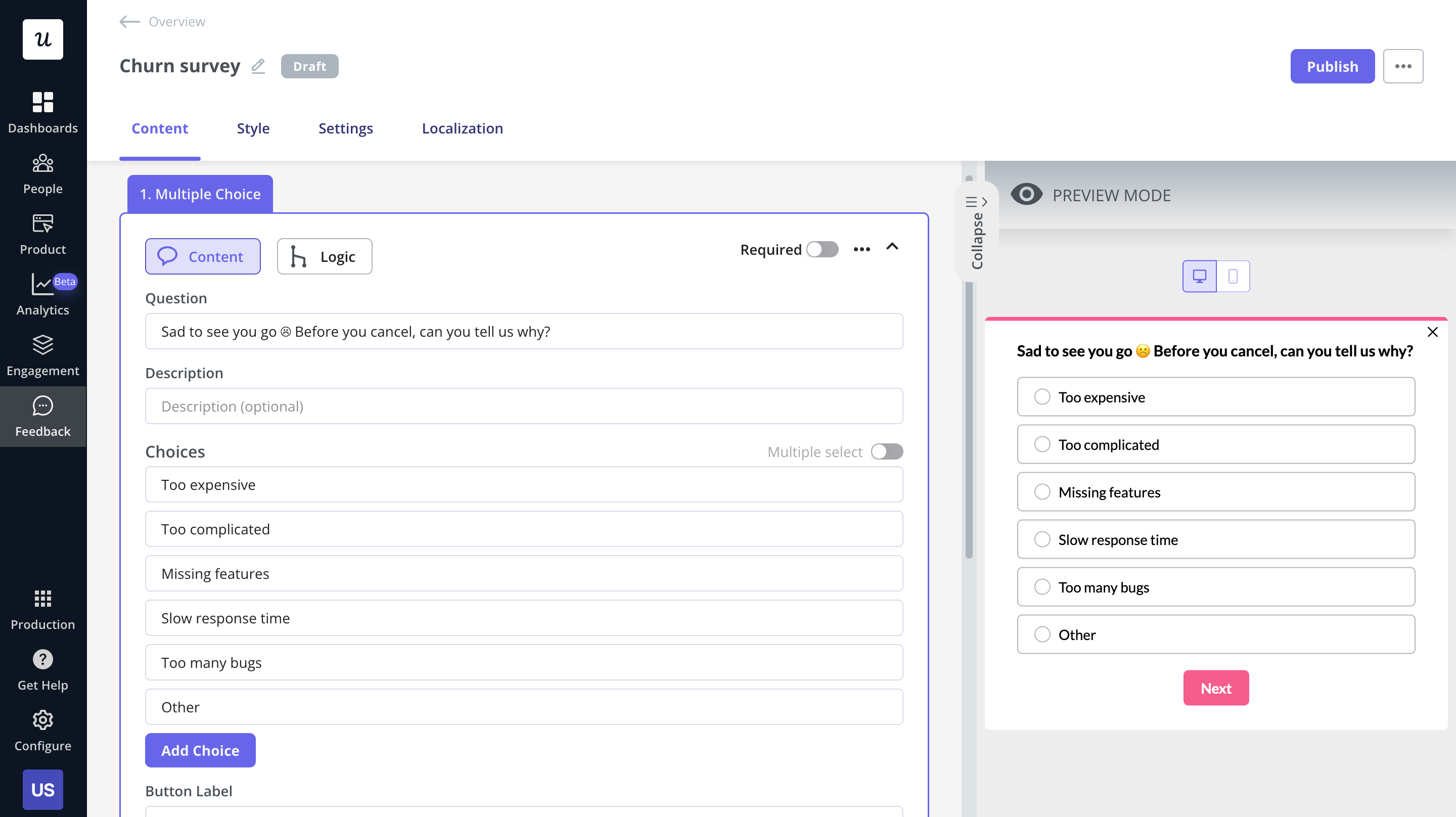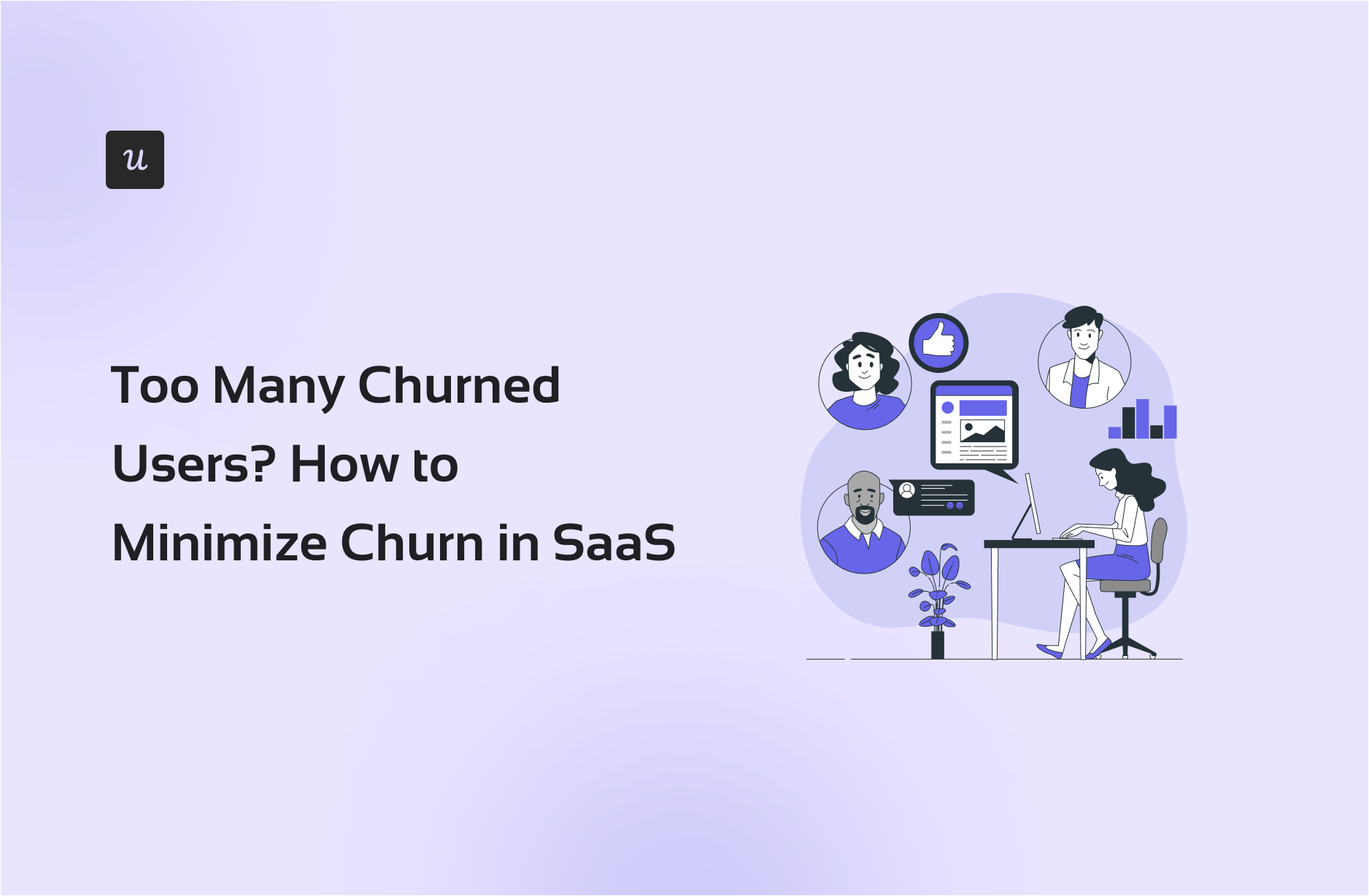Churn is the enemy of product growth. A churned user means lost future revenue and a waste of the resources it took to acquire them.
How do you lower your churn rate and make sure all your users stick around?
In this article, we’ll show you:
- What customer churn is and why it matters.
- How to calculate churn rate so you know where you stand.
- Common reasons why your churn rate may be too high.
- 6 strategies to improve your churn rate and retain more of your customer base.
Let’s get started.
TL;DR
-
- Customer churn occurs when customers cancel their subscription to a product or service.
- A churned user matters because it’s harmful to growth. For one, churned users leave negative reviews. And it’s more expensive to acquire new customers rather than retain them.
- High customer churn tanks future growth because it’s hard to offset the loss in monthly recurring revenue.
- Calculating churn can be completed with three methods. To calculate the churn rate, divide the number of churned users in a given period by the total number of customers at the start of the period. Then multiply it by 100.
- Revenue churn is how much money you’ve lost because of cancellations. To calculate this figure, divide the net revenue lost from existing customers in a given period by the total revenue at the beginning of the period.
- To calculate your negative churn (net MRR churn rate), first, subtract your expansion MRR from your churned MRR. Then, divide that by your starting MRR and multiply that number by 100.
- If you’re a SaaS company, the ideal churn rate is between 5-7%. If you’re a newer startup, your churn rate will likely be higher.
- There are four main reasons why customers churn. First, you may have failed to onboard new customers and deliver value.
- Another reason could be because of bad customer service given to an existing customer.
- Sometimes users churn because of price issues – either you misled them with the value of your product, or they don’t think the value matches the price outright.
- Finally, customers churn because of difficult user experiences that make it a struggle to use the product.
- To reduce your churn rate, start by personalizing your onboarding experience to meet specific user expectations.
- Also, collect customer feedback with surveys and analyze customer data with product analytics to make informed improvements.
- Proactively reach out to detractors who are at risk of churning and offer 1-on-1 help.
- If customers still want to cancel, ask them why they’re leaving in open-ended cancellation surveys. That will help you prevent future churn and attract the right users.
- Want to get started with churn management? Book a demo with Userpilot and we will show you how!
What is customer churn?
Customer churn (also called customer attrition) refers to the rate at which customers discontinue their usage or subscription to your product.
An increasing customer churn rate is a sign of a flawed product or service that is leaving customers dissatisfied. Inevitably, this hits your bottom line, and your revenue decreases.
Why does customer churn matter?
A high customer churn rate has detrimental effects on a business’ growth rates. Here’s why:
Churned users leave negative reviews
Unhappy customers leave negative reviews and warn others about their bad experience with a product or service.
This harms your reputation and makes customer acquisition even more difficult.
Whenever potential customers consider buying from you, most of the time they search for reviews on 3rd party sites first, like on G2. If you have negative reviews, that seriously impacts your ability to get new users.
Customer acquisition costs more than customer retention
It’s easier to retain customers than acquire them. So that means it’s easier to take care of your existing customers before they churn.
Acquisition is expensive – marketing and sales campaigns don’t run cheap. On the other hand, it’s cheaper to leverage your existing product team to improve the experience to prevent customer attrition.
High customer churn tanks your future growth
High-scale churn harms your reputation and impacts your customer lifetime value. That leaves you with no space for growth.
Sustainable growth is built on increasing your monthly recurring revenue (MRR) – and that’s impossible to do if you’re not retaining the customers you gain. Your MRR will stay stagnant, at best, or fall rapidly.
How to measure customer churn?
There are three main methods for calculating churn:
Calculate customer churn rate
Your customer churn rate is the number of customers that leave in a specific time frame – this can be annual, monthly, etc.
To calculate customer churn, use this simple formula: Divide the number of users lost during the period of interest by the number of users you had at the start of the period. Multiply the result by 100.
For example, if a company had 600 customers at the beginning of a specific time period and only 550 customers at the end, its customer churn rate would be 9.1%.

Customer churn rate formula
Calculate the revenue churn
The revenue churn figure is how much money you lose because of your churned customers.
To understand the true impact of a churned user on your business, you should calculate both your customer churn rate and your revenue churn. Why? Because it’s not the same to lose 1 customer worth $100 vs. 10 customers worth $1.
To calculate revenue churn, divide your MRR lost due to downgrades and cancellations over a certain time period by your MRR at the end of the previous month.

Revenue churn rate formula
Churn rate benchmarks in SaaS
There is no universal churn benchmark as rates differ across companies and industries. However, there are some averages you can compare with to understand where your company stands.
If you’re a SaaS company, an ideal annual churn rate should be between 5% – 7%, while the monthly churn rate should be below 1%.
If you’re a new startup, the average churn rate is typically a little higher at around 10% – 15%.
Main reasons for customer churn
Here are the four main reasons why a customer churns:
You failed to onboard new customers and drive value
New customers are more likely to churn since they haven’t been convinced of your product’s value yet. The onboarding stage is the most crucial time to drive value and convince new customers to stay.
If you have a high churn rate during or after the onboarding period, there are some common mistakes that you may be making:
- Irrelevant product tours: You’re wasting precious time showing users around your entire product with a tour. First of all, most features are not relevant to them or aren’t 100% necessary for achieving value right away. Also, product tours are forgettable when users don’t see the context of how features can help with their specific jobs to be done. Instead, limit your product tour to only the most essential features to start with.
- One-size-fits-all approach: For added value, personalize the product tour for each user segment. Your customer base has different reasons for turning to your product – whether they want to achieve different goals or have different issues that need resolving. By personalizing the product experience, you ensure that every customer gets the support they need to achieve their version of the value. To do this, use in-app surveys and user interviews to collect customer data. Then, split customers into different segments with similar characteristics and goals, and trigger experiences catered to those segments.
- Not providing contextual help: Churn occurs when customers feel like they’re not getting fast, contextual help along their journey. They expect a frictionless experience that’s catered to their needs. Friction makes the customer experience worse, contributing to user churn. Customers want their issues or questions resolved right away.
- Not collecting feedback from new signups: If you’re not collecting feedback, you’ll never know how to improve. Ask new customers what their initial experience’s been like, with some open-ended questions to gather detailed insights. Then, act on that customer feedback to start reducing churn.
You offered poor customer service to an existing customer
The quality of your customer support can make or break your business. A bad customer service experience will send customers leaving – and fast. Here are some common issues that add up to a poor customer service experience:
- Your customer service wasn’t personalized: Using a CRM, sync customer data across all of your support channels to give personalized customer service. Wherever customers reach out (live chat, email, social, etc.), conversations should pick up where they last left off.
- You lacked lacking self-service support: Most customers prefer self-service support. They don’t want to wait around for your customer support team to respond. Give your customers what they want with an in-app resource center filled with helpful articles, product demos, and video tutorials.
- You didn’t ask for feedback: After every customer service interaction, you should survey users for their feedback. Since the key to retaining customers is to give a positive experience, every interaction should be improved to reduce churn.
- You didn’t build strong relationships with your customers: Building trust and loyalty with your current customers is one of the best ways to boost user retention. They’re less likely to look at competitor options. To do this, reward them for referrals, celebrate product milestones, and reach out whenever they’re facing friction.
Price-based churned users due to a lack of value
Sometimes, customers stop using a product because it’s too expensive. It’s not always because they can’t afford it – it could be because of these reasons too:
- You overpromised in your messaging strategy: Maybe your marketing and sales teams positioned your product as more extensive than it is. When new users first signed up, the price seemed to match the product’s perceived value, but it didn’t match up in reality.
- The prices were high: Sometimes the budget is the problem. Some churned users cancel because they can no longer justify or afford the cost of your company’s products. Unfortunately, this is the most difficult one to avoid.
- The value didn’t match the price: Even if your messaging didn’t oversell your product, sometimes customers themselves expect more out of their experience. If they don’t achieve the level of value they expected, they end up churning.
Difficult user experience makes it hard to retain customers
A difficult user experience may be another culprit for your high churn rate. This can be because:
- You didn’t segment your users to provide personalized experiences: Customers expect a user experience that’s tailored to what they need at the moment. If you don’t segment your users so you can trigger personalized in-app messages, you’ll struggle to meet their needs.
- The customer journey was full of friction points: Friction frustrates customers. They don’t want to struggle with any part of their workflow. Fix friction points by analyzing user behavior – that will help you reduce customer churn.
- You didn’t use an onboarding checklist for a frictionless first-time customer experience: First impressions can make or break early customer retention. Generally speaking, you should use onboarding checklists to walk customers through how to use new features when they sign up. The more users you can get activated during the onboarding period, the more repeat visits you’ll get.
How to reduce customer churn and retain existing customers?
Try these six methods to reduce your churn rates and boost customer retention:
Personalize the onboarding process for new users
Use a welcome survey to learn about your customers and their jobs to be done (JTBD). Every new user who signs up has a specific goal or issue that they hope your product will help them achieve.
You need to figure out what this is to deliver them the most value. Use a welcome survey to learn more about your customers from the beginning.
After you segment users based on their responses, you can personalize their experience. The best place to start? Trigger personalized onboarding flows that showcase the features they need to complete their goals.

Create welcome surveys code-free with Userpilot
Collect customer feedback throughout the customer journey
Use net promoter score (NPS) and in-app surveys to collect user sentiment throughout the customer journey and fix friction points along the way.
To collect more data, use a follow-up on your NPS responses with an open-ended question.
NPS helps you measure customer loyalty and collect qualitative information about your product performance.
Then, you can use that feedback to make informed product improvements.

Create NPS surveys code-free with Userpilot.
Identify detractors and proactively reach out to retain them
Detractors (who scored 6 or lower on the NPS survey) are customers who are unlikely to recommend your product to others due to low satisfaction.
They’re also likely to become a churned user very soon. And you can prevent it before it happens!
To fix this, segment your detractors and proactively reach out to them to improve their experience.

Segment detractors based on NPS scores.
Provide good customer service
Good customer service can help you improve customer retention, drive brand loyalty, and reduce churn.
For the best customer support experience, create an in-app resource center to nurture self-service support and let users find answers to common questions.
It’s important to create different formats of resources such as tutorial videos, help articles, and more to cater to customers who want variety.

Offer self-service through a resource center. Create one code-free with Userpilot
Analyze customer behavior in different customer segments
Customer behavior data lets you identify users that are likely to churn.
You can study user activity trends by looking at your product analytics and reaching out to inactive segments.
This will also help you notice the behaviors that contribute to churn. You can build your customer experience around improving them. For example, do inactive users miss out on important onboarding steps? Or don’t use critical features enough?

Monitor user behavior with an analytics dashboard
To retain customers, you can build in-app product experiences that encourage effective actions.
Identify drop-offs in the user journey and fix them to prevent churn
Monitoring the user journey can be a good starting point to identify friction points, but you should delve deeper by reviewing screen recordings or conducting interviews.
Conversion funnel analysis is the most straightforward way to diagnose the problem so you can start fixing it before the rest of your user base starts churning. Funnel charts show you the exact drop-off rates between each step of your funnels.
Once you have discovered why customers are dropping off, act on the data to prevent churn.

Use funnel analysis to identify points of friction.
Understand the reasons behind churn with cancellation surveys
Use cancellation surveys to get qualitative data on why users churn. Ask them why they’re leaving with open-ended questions that leave them room to give contextual feedback.
Do they want specific features? Or integrations with other products? Do they find the user experience too difficult to navigate?
These are key insights that will help your product leaders make impactful decisions.
Then, use this data to make necessary improvements to reduce your future churn rate.

Create a churn survey with Userpilot.
Conclusion
High churn rates kill any chance of building sustainable growth in a business. Complete a churn analysis and build a better product experience to prevent churn – you’ll struggle less with customers lost to cancellations.
Want to create contextual experiences that drive retention? Book a demo call with our team and get started!



